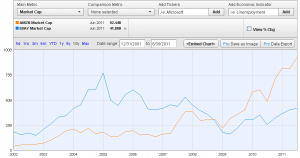AMZN and EBAY are both eCommerce platforms which sell products online, however EBAY does not manage any warehouses because it operates the platforms only, its major challenge is to ensure the quality of products listed there and help establish a credit system for sellers, while AMZN manages huge warehouses as AMZN itself is the biggest seller on its own platform, quality of the products and the credit of seller is lesser problem for AMZN, its major challenge is to manage the cost of inventory and warehouses and deliveries.
Using market cap of AMZN and EBAY as proxy for Business To Consumer (B2C) and Consumer TO Consumer (C2C) market, this is an interesting chart of their dynamics over last 10 years. It shows that at the early Internet years, C2C market is bigger and peaked first, while B2C market catch up later on and exploded in exponential rate a few years after C2C market’s peak. EBAY or platform only model has an early and fast win because it quickly reaches wide variety of products, while in early days, the fact that number of sellers is small ensures a balance between quality and profit for sellers. However, as more and more sellers enters the market, competetion becomes more intensive, it becomes harder and harder to maintain high profit margin for high quality sellers on C2C marketplace, so those sellers and their products leave the market, leaving the low quality sellers who sell fake products which will turn away consumers. While in B2C model, quality is guaranteed as AMZN itself is seller. This chart reflects that over long term, quality of products at reasonable prices are what attract and keep bringing back consumers to a marketplace.
